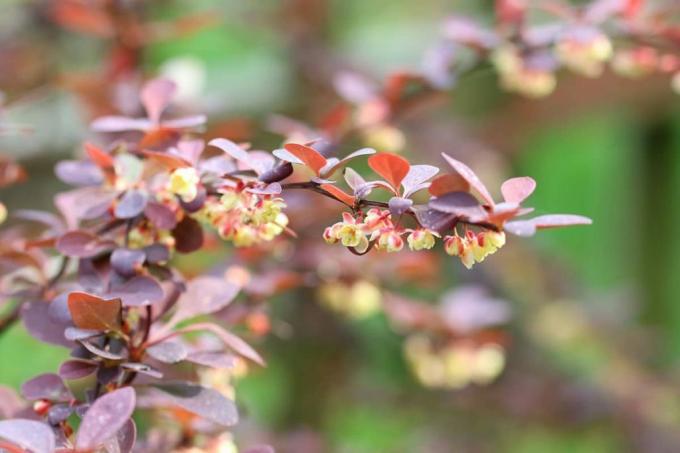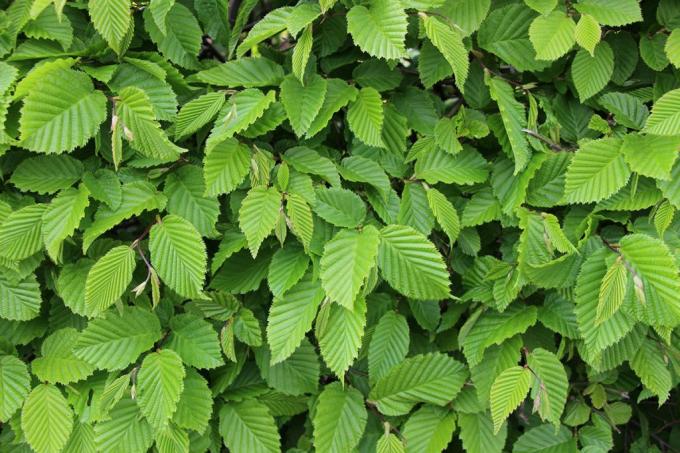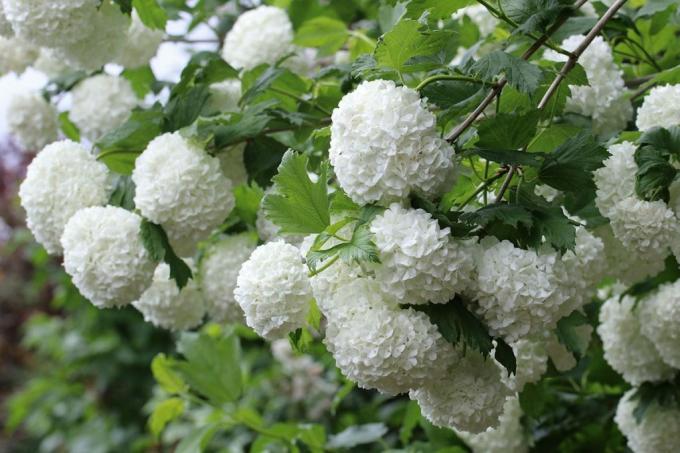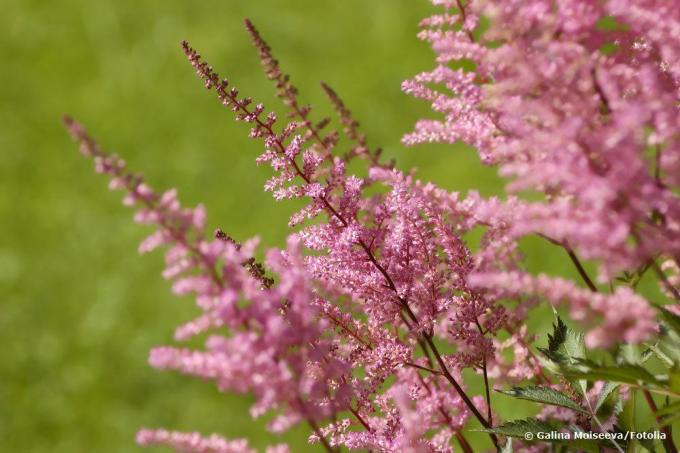
table of contents
- Shrubs
- Conifers & Evergreens
- Flowering shrubs & wild trees
- frequently asked Questions
Cherry laurel has now fallen into disrepute because it is not usable for the local animal world. In addition, the invasive species is spreading and displacing native woody plants. We introduce you to 15 beautiful alternatives to cherry laurel.
In a nutshell
- Cherry laurel ecologically questionable: no food for birds and insects
- spreads invasively in nature in some regions
- prefer native woody plants when planting in the garden
- Pay attention to bee and bird friendly species
- above all choose flowering and fruiting trees
Shrubs
Blood barberry / red hedge barberry (Berberis thunbergii 'Atropurpurea')
- attractive red foliage, yellow flowers between May and June
- very dense growth, high output
- cut-resistant and undemanding in terms of soil and maintenance
- needs a sunny to partially shaded location
- Spread: up to two meters
- Height: up to three meters
- Growth rate: 20 to 40 centimeters per year

Note: The blood barberry is one of the most beautiful alternatives to cherry laurel, especially since it also provides food and protection for the local fauna. It is considered to be a nourishing and protecting wood for bees and birds.
Field maple (Acer campestre)
- very easy to cut, robust and windproof
- also suitable for high hedges
- native bird protection wood
- loves calcareous soils, for sun and partial shade
- Spread: up to ten meters
- Height: up to 15 meters
- Growth rate: 30 to 45 centimeters per year

Green hedge barberry (Berberis thunbergii)
- densely branched growth, forms many shoots
- robust and very hardy
- very suitable for acidic soils
- Spread: up to 220 centimeters
- Growth height: up to 250 centimeters
- Growth rate: 20 to 35 centimeters per year

Note: The hedge barberry is a nice alternative to Cherry laurel. she forms dense hedges, in the protection of which birds like to breed. In autumn, the beautiful, scarlet autumn color of this species is also evident.
Hornbeam / Hornbeam (Carpinus betulus)
- native, deciduous wild wood
- very easy on cutting, ideal for hedges
- shade-tolerant and undemanding
- Spread: up to 750 centimeters
- Height: up to 14 meters
- Growth rate: 30 to 35 centimeters per year

Common beech (Fagus sylvatica)
- native, robust wild wood
- very well tolerated by shadows and cuts
- dense foliage, very suitable for hedges
- Spread: up to eight meters
- Height: up to 30 meters
- Growth rate: 20 to 50 centimeters per year

Note: the European beech as a domestic alternativeis not suitable for very dry locations, as it is quite sensitive to prolonged drought. Therefore water every now and then in midsummer!
Conifers & Evergreens
Yew tree (Taxus baccata)
- native, evergreen species with dark needles
- forms bright red fruit decorations, is eaten by birds
- very well tolerated by pruning, good suitability for hedges and topiary trees
- undemanding in terms of location and care, tolerates shade
- Spread: up to eight meters
- Height: up to ten meters
- Growth rate: 20 to 30 centimeters per year

Note: The yew tree is one of the best domestic alternatives to cherry laurel, but it is highly toxic. All parts of the plant are toxic, especially since the bright red fruits could encourage small children to snack.
European holly (Ilex aquifolium)
- for weakly acidic to acidic soils
- very good shade tolerance
- forms bright red fruits that are eaten by birds
- very suitable for hedges and topiary
- Spread: up to six meters
- Height: up to ten meters
- Growth rate: rather slow

Note: The attractive holly as an alternative to cherry laurel is also not entirely harmless: its fruits are highly toxic, in addition, the leaf margins are studded with sharp teeth.
Common Juniper (Juniperus communis)
- native, very robust conifer for nutrient-poor, gravelly soils
- forms black fruits that birds like to eat
- very frost hardy, copes well with drought
- often picturesque, bizarre growth
- Spread: up to five meters
- Height: up to eight meters

Tip: There are numerous beautiful varieties with different growth forms as alternatives to cherry laurel, for example the 'Green Carpet', which grows like a carpet, or the Irish columnar juniper 'Hibernica'.
Flowering shrubs & wild trees
Firethorn (Pyracantha coccinea)
- attractive ornamental fruit plant with evergreen leaves
- numerous white flowers between May and June
- for individual positions, group planting and hedges
- sunny to partially shaded location
- Spread: up to four meters
- Height: up to four meters

Note: Contrary to popular belief, the bright red or orange ones are Firethorn fruits not poisonous, but taste very sour.
Common snowball (Viburnum opulus)
- large, white flowers from May to June
- wonderful leaf color in autumn
- native wild plant
- for shady to partially shaded locations
- Spread: up to four meters
- Height: up to five meters

Tip: Other types of snowball such as the woolly snowball (Viburnum lantana) are ecologically valuable and at the same time attractive woody plants for the garden and therefore recommended as an alternative to cherry laurel.
Crackling willow (Salix fragilis)
- shrub-like, often multi-stemmed growth
- glossy, dark green leaves, deciduous
- Greenish yellow catkins in spring, important for bees and bumblebees
- for a sunny to partially shaded location with fresh to moist soil
- Height: up to 15 meters

Cornelian cherry (Cornus mas)
- Large shrub that tolerates pruning, often with multiple stems
- bright yellow flowers from March to April
- edible red fruits in autumn
- valuable native wild wood for insects and birds
- Spread: up to 350 centimeters
- Height: up to five meters
- Growth rate: 10 to 30 centimeters per year

Euonymus europaeus
- also known as the common spindle tree
- native, very robust wild wood, valuable bee pasture
- tolerates both floods and drought
- beautiful autumn colors, attractive fruit decorations
- Spread: up to 350 centimeters
- Height: up to six meters
- Growth rate: 20 to 25 centimeters per year

Note: As with so many other attractive garden plants as alternatives to cherry laurel, the leaves and fruits of the Pfaffenhütchens highly poisonous.
Spiraea vanhouttei
- picturesque, broad, bushy growth that overhangs when old
- numerous semicircular flower clusters between May and June
- undemanding and easy to cut
- very good for group or hedge planting
- Spread: up to 200 centimeters
- Growth height: up to 300 centimeters
- Growth rate: 20 to 50 centimeters per year

Scarlet thorn (Crataegus coccinea)
- large shrub with multiple stems
- intense autumn colors, scarlet berries
- tolerates drought, grows on almost all soils
- for sunny and warm locations
- Spread: up to five meters
- Height: up to seven meters
- Growth rate: 20 to 30 centimeters per year

frequently asked Questions
Cherry laurel is problematic for a number of reasons. The shrub does not provide any food for birds or insects, and the clippings cannot be composted. Instead, the material is often dumped in the forest. It then grows there and, due to its rapid growth, displaces native woody plants.
Basically, neither of the two types is recommended for an ecologically sensible garden. Instead, rely on native woody species. Among them you have a large selection of attractive varieties - and with which you can do something good for nature.
If you want to forego cherry laurel and thuja but are still looking for a fast-growing hedge, try the hornbeam. Given favorable location conditions, this has quite high growth rates. In addition, the leaves that have dried up in autumn remain on the bush through winter, so that privacy is provided all year round. Field maple and red beech are also fast-growing.
